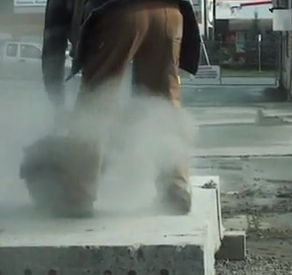
Image from WorkSafeBC’s Silica Exposure
I saw the question on Twitter recently, with a link to this story in the Vancouver Sun about the risks of exposure to silica dust in stone, bricks, tile, and gravel.
Workers who grind, cut, and haul these materials are at risk of developing silicosis – a lung disease that destroys lung tissue and restricts a person’s ability to breathe.
People have been talking about the risks of asbestos exposure – and the now the risks of silica exposure are also garnering much-needed attention. One example is WorkSafeBC’s proposed new rules to reduce this risk for up to 40,000 workers in BC. The Sun story said 2014 is when the proposed rules will be out for public consultation.
I suggest you go read the full article I’m quoting these figures from – but in the meantime, consider this: Between 1987 and 2011, the cost of claims from silicosis was $29.6 million and there was $79.7 million paid in claims for asbestosis and $128.9 million from cancer linked to asbestos.
The story quotes Grant McMillan, president of the Council of Construction Associations.
“Silica dust has been a bit of a sleeper, but it’s still a real safety concern from the point of view of lung disease,” he told the Sun. “I think WorkSafe is being wise in looking at silica dust and ensuring there are safe work practices. In construction, as elsewhere, if people don’t take the proper precautions, then they definitely have an increased risk of developing lung disease.”
Proposed new rules will address silica exposure in different industries – particularly construction and manufacturing. They will involve requirements for training, risk assessment, exposure control plans, and monitoring exposures. In the past, rock dust risk was considered mostly in relation to the work of hard rock miners but not these other industries.
The video below includes an amazing animation that shows how silica dust particles are inhaled from the air and absorbed into the lungs. It reminds us that effects from exposure may not show up for a long time, so it’s not a risk that’s apparent unless you hear about it. So let’s spread the word.
More info on minimizing risk
Silica – here you will find a list of resources from WorkSafeBC and its partners.


